The NVIDIA GeForce GTX 1660 Super Review, Feat. EVGA SC Ultra: Recalibrating The Mainstream Market
by Ryan Smith on October 29, 2019 9:00 AM ESTPower, Temperatures, & Noise
Last, but not least of course, is our look at power, temperatures, and noise levels. While a high performing card is good in its own right, an excellent card can deliver great performance while also keeping power consumption and the resulting noise levels in check.
| NVIDIA GeForce Video Card Voltages | ||
| Model | Boost | Idle |
| EVGA GTX 1660 Super Ultra SC | 1.05v | 0.618v |
| GeForce GTX 1660 | 1.043v | 0.656v |
| GeForce GTX 1660 Ti | 1.005v | 0.65v |
Using the same TU116 GPU as the GTX 1660 Ti and the GTX 1660 (vanilla0, the voltages are unsurprisingly similar. 1.05v is essentially a universal limit for NVIDIA Turing GPUs at stock, while the idle voltage of 0.618v is a bit lower than what we’ve seen on other TU116 cards thus far.
| GeForce Video Card Average Clockspeeds | |||||
| Game | GTX 1660 Super (Ref Clocks) |
EVGA GTX 1660 Super SC Ultra |
GTX 1660 Ti | GTX 1660 | |
| Max Boost Clock | 1935MHz | 1980MHz | 1950MHz | 1935MHz | |
| Boost Clock | 1785MHz | 1830MHz | 1680MHz | 1785MHz | |
| Shadow of the Tomb Raider | 1860MHz | 1905MHz | 1875MHz | 1875MHz | |
| F1 2019 | 1860MHz | 1905MHz | 1890MHz | 1875MHz | |
| Assassion's Creed: Odyssey | 1875MHz | 1920MHz | 1905MHz | 1890MHz | |
| Metro: Exodus | 1860MHz | 1905MHz | 1890MHz | 1875MHz | |
| Strange Brigade | 1860MHz | 1905MHz | 1890MHz | 1890MHz | |
| Total War: Three Kingdoms | 1860MHz | 1890MHz | 1890MHz | 1875MHz | |
| The Division 2 | 1845MHz | 1875MHz | 1875MHz | 1860MHz | |
| Grand Theft Auto V | 1875MHz | 1920MHz | 1905MHz | 1890MHz | |
| Forza Horizon 4 | 1875MHz | 1905MHz | 1905MHz | 1890MHz | |
The situation with clockspeeds is also very similar, though not entirely a carbon copy of the GTX 1660 (vanilla). Even with NVIDIA’s slightly higher TDP, our GTX 1660 Super card sees a very slight drop in clockspeeds, typically coming in one bin (15MHz, or under-1%) below the original card. In this case it’s a tradeoff we’re glad to take, since as we’ve just seen, the extra memory bandwidth on the GTX 1660 Super more than makes up for any clockspeed deficit, launching the Super card well ahead of its GDDR5-based predecessor.
In any case, the GTX 1660 Super once again comes in well ahead of NVIDIA’s official boost clock specifications. Even under The Division 2, average clockspeeds beat the spec by 60MHz, and in other games It’s more frequently 75 to 90MHz above.
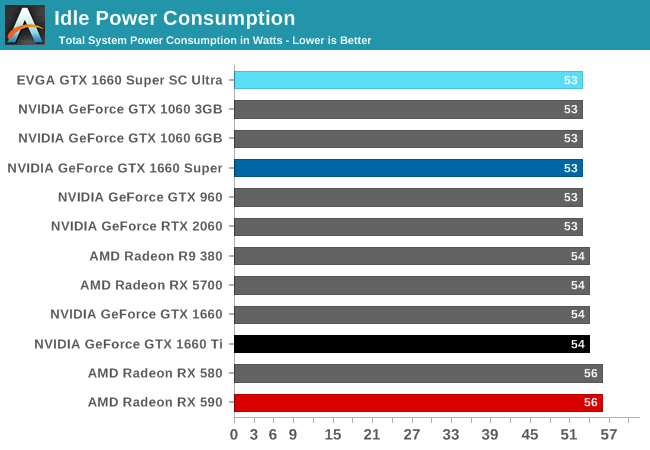
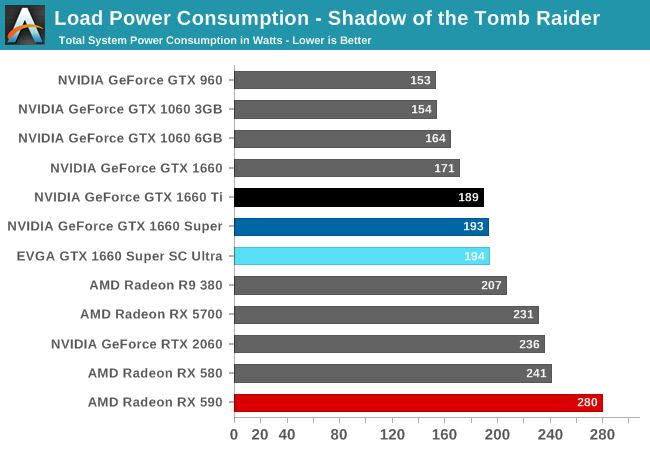
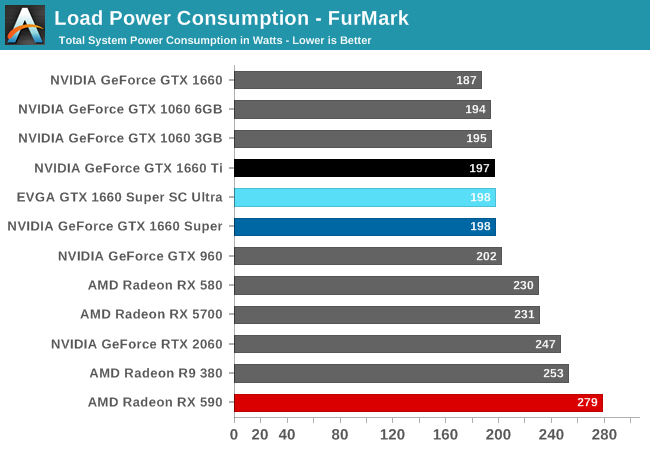
Shifting to power consumption, our results are in line with NVIDIA’s specifications, as well as what we’d expect for yet another TU116 card. With its 125W TGP, the GTX 1660 Super draws ever so slightly more power than either the GTX 1660 Ti or the GTX 1660, particularly in Tomb Raider where the CPU gets a bit more of a workout as well. But on the whole, it’s right in the ballpark with other 120W(ish) NVIDIA cards, with power consumption at the wall for the entire testbed not exceeding 200W.
For the midrange segment, the GTX 1660 Super (and the GTX 1660 Ti) are the cards to beat when it comes to power consumption and efficiency. Everything else at this power level performs much slower, or it’s faster while requiring more power. Though faster cards aren’t too far off, as the RX 5700 can attest to.
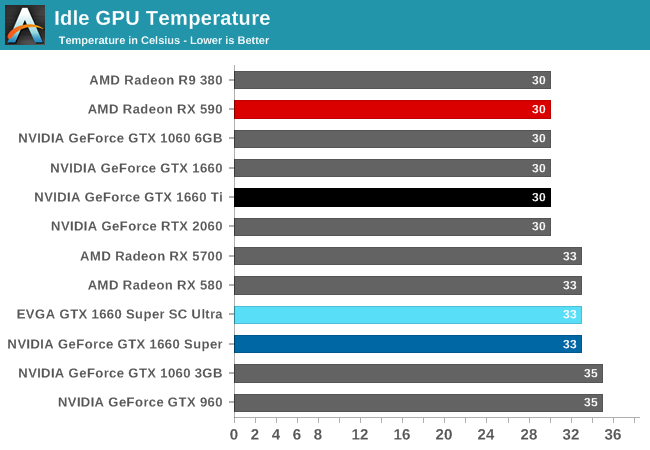


As for temperatures, EVGA has delivered one cool running card. Even at its full, factory overclocked speeds, the EVGA GTX 1660 Super SC Ultra never cracks 70C, and under FurMark’s pathological workload it’s the second-quietest card in these cards.
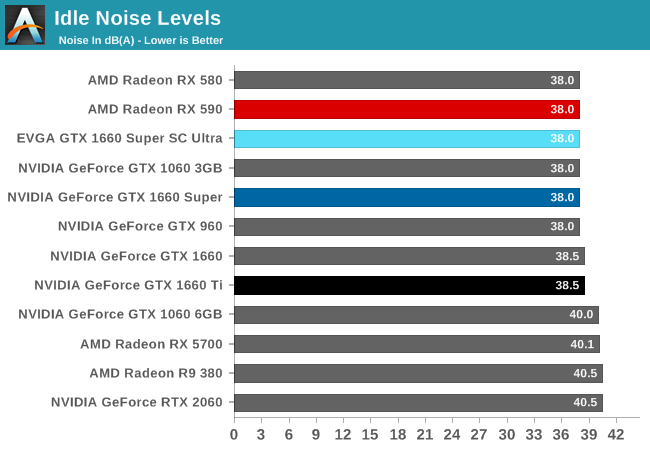

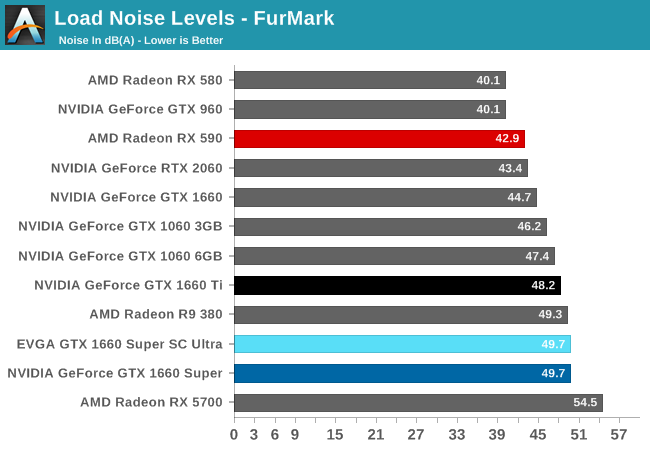
The tradeoff for those temperatures, however, is noise. The EVGA card that delivers chart-topping temperatures also delivers some of the worst noise results among this collection of cards.
The culprit here would seem to be EVGA’s decision to bias the card towards cooling performance rather than acoustics. Which given how far the card is from its 83C thermal throttle point, seems overdone. EVGA could easily back off on the fan speed a bit, let the temperatures drift up to the low 70s, and deliver essentially the same gaming performance (perhaps losing 1 bin in the process) while generating a lot less noise. We have a number of 120W open air cards in these cards, including the GTX 1660 3GB and GTX 960, both of which move just as much heat with much less noise, so it can be done. And, to be fair to EVGA here, their SC Ultra card is by no means a tornado, barely hitting 50 dB(A) in these intensive, open case tests, but the best cards strike a proper balance between noise and performance, maximizing the latter while minimizing the former.
Ultimately, I suspect part of the engineering challenge EVGA is dealing with here is that the SC Ultra cooler is their smallest GTX 1660 cooler. The triple-slot XC cards (represented here with the GTX 1660 Ti and GTX 1660) have just one fan and much bigger heatsinks to work with. Similarly, EVGA also sells longer dual-slot cards (also called XC) which get the benefit of a longer heatsink. The physics of more heatsink mass (and more/bigger fins) can’t be ignored, which is why smaller cards often need to run faster fans. Still, even if the SC Ultra cooler isn’t particularly big, I do think there’s room for a better fan balance here.
Tangentially, as I mentioned in the EVGA SC Ultra overview, this is actually our second card. The original was even hotter and louder; it reached 75C and 54.6 dB(A) under Tomb Raider in that test. Considering that these GTX 1660 Super cards are operating near or at their power limits and are TDP-capped by the VRMs and monitoring hardware – and thus, one card can’t draw significantly more power than another identical card – it points to a cooling problem with the card itself. EVGA has since taken the card back to figure out what’s going on, but I suspect what they’ll find is poor thermal transfer between the GPU and heatsink, perhaps due to a bad TIM application or a problem with the heatpipes. Ultimately it’s rare that we get dud video cards, but it does happen now and then.


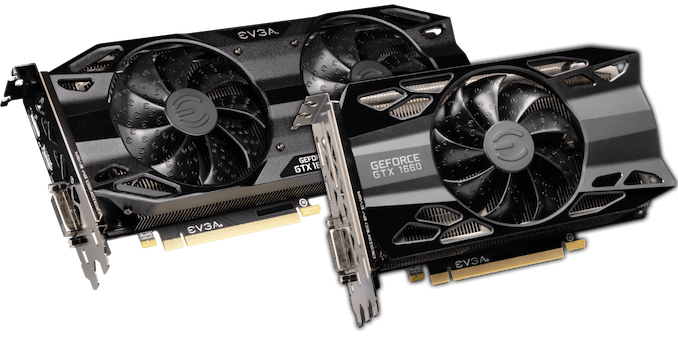








65 Comments
View All Comments
PeachNCream - Tuesday, October 29, 2019 - link
Just a thought, if the crashing was ONLY in Chrome, I would have just used another web browser. Chrome is sort of like a windowless van with the words Free Candy spray painted on the side filled with sticky handed Google programmers eager for your delicious personal information anyway. I'd put up with crappy Edge or bloated Firefox before letting Alphabet have a freebie by installing their browser on any computer I was planning to do something I wanted to keep to myself.Alistair - Tuesday, October 29, 2019 - link
Turned out it isn't just Chrome, I just meant, even just using Chrome it randomly crashes. I've swapped the Gigabyte 5700 XT for an MSI one, but it might be driver related. And I'm not totally blaming AMD for it, because Windows has been hell with drivers recently. All the Realtek drivers are messed up since the last Windows update... sigh...maroon1 - Wednesday, October 30, 2019 - link
The 2GB more Vram has no benefit on these weak cardsStrangerGuy - Thursday, October 31, 2019 - link
Well, it really depends on local pricing. Over here in Singapore the 580/590/1660 Ti is a massive ripoff versus the 2060 non-S.Anyway all of these new cards are still a perf/$ snoozefest for a 1070 owner like me.
pivejasey - Tuesday, October 29, 2019 - link
The most important benchmark for computing on a nvidia card is tensorflow, and I'm always dissapointedfor getting no data.Ryan Smith - Tuesday, October 29, 2019 - link
Hmm. Is there a specific benchmark you'd like to see? And that runs under Windows without extensive work?eastcoast_pete - Tuesday, October 29, 2019 - link
Thanks Ryan! Question: Which version of NVENC does the 1660 Super have? Turing's like the 1660 Ti, or (still) Volta like the 1660. I know it's a bit of a niche use case, but some of us like to transcode and compress our 4K footage or stream games live. The Turing ASIC is significantly better at HVEC encoding, so, if the Super has that one, it might be worth looking into for me.Ryan Smith - Tuesday, October 29, 2019 - link
GTX 1660 Super is TU116, so it has the Turing NVENC block.xrror - Tuesday, October 29, 2019 - link
Just adding that Ryan mentioned in the 1650 Super article that 1650 Super also will use TU116, so maybe an even lower cost option to consider? (assuming it can also handle the 4K footage)eastcoast_pete - Wednesday, October 30, 2019 - link
Appreciate that, however, NVIDIA used the Volta NVENC in a Turing GPU in the 1650, so if the 1650 Super has an unchanged GPU, it probably still has that backwards hybrid of old NVENC with Turing GPU. Ryan, do you have any updates on this?